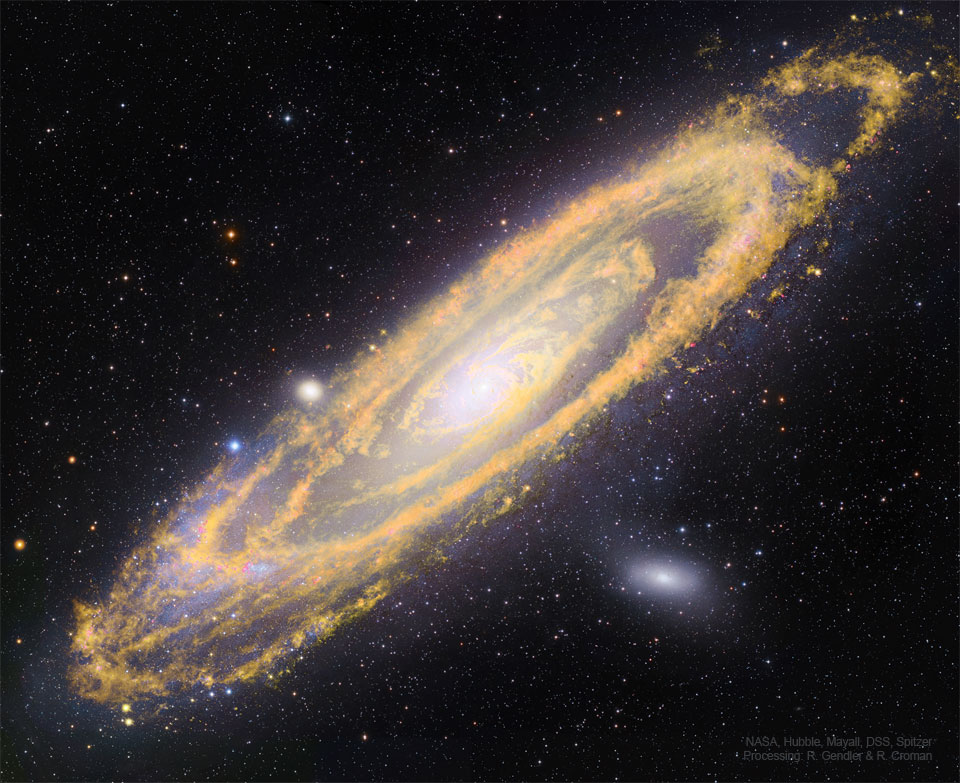07. October 2023
仙女座星系 過去 kah 未來 ê 恆星

探索宇宙1!逐工會揀一幅無仝款 ê 影像抑是相片,𤆬你熟似咱這个迷人 ê 宇宙,閣有專業天文學者2為你解說3。
- 原始文章:The Once and Future Stars of Andromeda
- 影像來源:NASA, NSF, NOAJ, Hubble, Subaru, Mayall, DSS, Spitzer; 影像處理 kah 版權:Robert Gendler & Russell Croman
- 台文翻譯:An-Li Tsai (NSYSU)
[漢羅] 仙女座星系 過去 kah 未來 ê 恆星
這張仙女座星系 ê 相片,毋若看會著恆星 tī 佗位,嘛看會著欲出世 ê 恆星會出現 tī 佗位。 仙女座星系 M31 是一个 捲螺仔星系。 伊遮爾大閣遮爾媠,離咱干焦 250 萬 光年 爾爾。 這張足心適 ê 仙女座星系相片,是 kā 太空觀測 kah 地面觀測 tī 可見光波段以內 kah 以外 ê 影像,疊做這張–ê。 可見光 看著–ê,是 M31 內底 ê 恆星。 白色 kah 藍色是 Hubble 太空望遠鏡、Subaru 地面望遠鏡、kah Mayall 地面望遠鏡 ê 影像資料。 紅外線 看著–ê,是 M31 內底,連鞭欲出世 ê 新恆星。 In 是柑仔色–ê,是 NASA Spitzer 太空望遠鏡 ê 影像資料。 紅外線會當追蹤大型 塗粉帶。 塗粉帶會去予恆星加溫,伊綴 仙女座星系 ê 捲螺仔手骨咧行。 這寡 塗粉 是星系內底 大量星際氣體 ê 追蹤劑。 這寡星際氣體,就是未來欲 做新恆星 ê 原始材料。 仙女座星系 會 tī 未來 50 億年 ê 時間內,kah 咱 銀河系 合併 做一个星系。 Tī 彼進前,這寡新恆星應該會 先做出來,差不多 tī 紲落來幾若億年 ê 時間內。
[POJ] Sian-lú-chō seng-hē kòe-khì kah bī-lâi ê hêng-chhiⁿ
Chit tiuⁿ Sian-lú-chō seng-hē ê siòng-phìⁿ, m̄-nā khòaⁿ-ē-tio̍h hêng-chhiⁿ tī to̍h ūi, mā khòaⁿ-ē-tio̍h beh chhut-sì ê hêng-chhiⁿ ē chhut-hiān tī to̍h-ūi. Sian-lú-chō seng-hē M31 sī chi̍t ê kńg-lê-á seng-hē. I chiah-nī tōa koh chiah-nī súi, lî lán kan-na 250 bān kng-nî niā-niā. Chit tiuⁿ chiok sim-sek ê Sian-lú-chō seng-hē siòng-phìⁿ, sī kā thài-khong koan-chhek kah tē-bīn koan-chhek tī khó-kiàn-kng pho-tōaⁿ í-lâi kah í-gōa ê iáⁿ-siōng, tha̍h chò chit tiuⁿ–ê. Khó-kiàn-kng khòaⁿ–tio̍h–ê, sī M31 lāi-té ê hêng-chhiⁿ. Pe̍h-sek kah nâ-sek sī Hubble thài-khong bōng-oán-kiàⁿ, Subaru tē-bīn bōng-oán-kiàⁿ, kah Mayall tē-bīn bōng-oán-kiàⁿ ê iáⁿ-siōng chu-liāu. Âng-gōa-sòaⁿ khòaⁿ–tio̍h–ê, sī M31 lāi-té, liâm-mi beh chhut-sì ê sin hêng-chhiⁿ. In sī kam-á-sek–ê, sī NASA Spitzer thài-khong bōng-oán-kiàⁿ ê iáⁿ-siōng chu-liāu. Âng-gōa-sòaⁿ ē-tàng tui-chong tōa-hêng thô͘-hún-tòa. Thô͘-hún-tòa ē khì hō͘ hêng-chhiⁿ ka-ūn, i tòe Sian-lú-chō seng-hē ê kńg-lê-á chhiú-kut leh kiâⁿ. Chit-kóa thô͘-hún sī seng-hē lāi-té tōa-liōng seng-chè-khì-thé ê tui-chong-che. Chit-kóa seng-chè-khì-thé, to̍h sī bī-lâi beh chò sin hêng-chhiⁿ ê goân-sú châi-liāu. Sian-lú-chō seng-hē ē tī bī-lâi 50 ek nî ê sî-kan lāi, kah lán Gîn-hô-hē ha̍p-pèng chò chi̍t ê seng-hē. Tī he chìn-chêng, chit-kóa sin hêng-chhiⁿ èng-kai ē seng chò–chhut-lâi, chha-put-to tī sòa–lo̍h-lâi kúi-ā ek nî ê sî-kan lāi.
[KIP] Sian-lú-tsō sing-hē kuè-khì kah bī-lâi ê hîng-tshinn
Tsit tiunn Sian-lú-tsō sing-hē ê siòng-phìnn, m̄-nā khuànn-ē-tio̍h hîng-tshinn tī to̍h uī, mā khuànn-ē-tio̍h beh tshut-sì ê hîng-tshinn ē tshut-hiān tī to̍h-uī. Sian-lú-tsō sing-hē M̀1 sī tsi̍t ê kńg-lê-á sing-hē. I tsiah-nī tuā koh tsiah-nī suí, lî lán kan-na 250 bān kng-nî niā-niā. Tsit tiunn tsiok sim-sik ê Sian-lú-tsō sing-hē siòng-phìnn, sī kā thài-khong kuan-tshik kah tē-bīn kuan-tshik tī khó-kiàn-kng pho-tuānn í-lâi kah í-guā ê iánn-siōng, tha̍h tsò tsit tiunn–ê. Khó-kiàn-kng khuànn–tio̍h–ê, sī M̀1 lāi-té ê hîng-tshinn. Pe̍h-sik kah nâ-sik sī Hubble thài-khong bōng-uán-kiànn, Subaru tē-bīn bōng-uán-kiànn, kah Mayall tē-bīn bōng-uán-kiànn ê iánn-siōng tsu-liāu. Âng-guā-suànn khuànn–tio̍h–ê, sī M̀1 lāi-té, liâm-mi beh tshut-sì ê sin hîng-tshinn. In sī kam-á-sik–ê, sī NASA Spitzer thài-khong bōng-uán-kiànn ê iánn-siōng tsu-liāu. Âng-guā-suànn ē-tàng tui-tsong tuā-hîng thôo-hún-tuà. Thôo-hún-tuà ē khì hōo hîng-tshinn ka-ūn, i tuè Sian-lú-tsō sing-hē ê kńg-lê-á tshiú-kut leh kiânn. Tsit-kuá thôo-hún sī sing-hē lāi-té tuā-liōng sing-tsè-khì-thé ê tui-tsong-tse. Tsit-kuá sing-tsè-khì-thé, to̍h sī bī-lâi beh tsò sin hîng-tshinn ê guân-sú tsâi-liāu. Sian-lú-tsō sing-hē ē tī bī-lâi 50 ik nî ê sî-kan lāi, kah lán Gîn-hô-hē ha̍p-pìng tsò tsi̍t ê sing-hē. Tī he tsìn-tsîng, tsit-kuá sin hîng-tshinn ìng-kai ē sing tsò–tshut-lâi, tsha-put-to tī suà–lo̍h-lâi kuí-ā ik nî ê sî-kan lāi.
[English] The Once and Future Stars of Andromeda
This picture of Andromeda shows not only where stars are now, but where stars will soon be. Of course, the big, beautiful Andromeda Galaxy, M31, is a spiral galaxy – and a mere 2.5 million light-years away. Both space-based and ground-based observatories have been here combined to produce this intriguing composite image of Andromeda, at wavelengths both inside and outside normally visible light. The visible light shows where M31’s stars are now – as highlighted in white and blue hues and imaged by the Hubble, Subaru, and Mayall telescopes. The infrared light shows where M31’s future stars will soon form – as highlighted in orange hues and imaged by NASA’s Spitzer Space Telescope. The infrared light tracks enormous lanes of dust, warmed by stars, sweeping along Andromeda’s spiral arms. This dust is a tracer of the galaxy’s vast interstellar gas – the raw material for future star formation. These new stars will likely form over the next hundred million years, surely well before Andromeda merges with our Milky Way Galaxy in about 5 billion years.
詞彙學習(漢羅/POJ/KIP/華語/English)
- 【仙女座星系】Sian-lú-chō seng-hē/Sian-lú-tsō sing-hē/仙女座星系/the Andromeda Galaxy
- 【M31】M saⁿ-cha̍p-it/M sann-tsa̍p-it/M31/M31
- 【捲螺仔星系】kńg-lê-á seng-hē/kńg-lê-á sing-hē/螺旋星系/spiral galaxy
- 【捲螺仔手骨】kńg-lê-á chhiú-kut/kńg-lê-á tshiú-kut/螺旋手臂、旋臂/spiral arms
- 【塗粉帶】thô͘-hún-tòa/thôo-hún-tuà/灰塵帶/dust lane
- 【追蹤劑】tui-chong-che/tui-tsong-tse/追蹤劑/tracer
- 【星際氣體】seng-chè-khì-thé/sing-tsè-khì-thé/星際氣體/interstellar gas